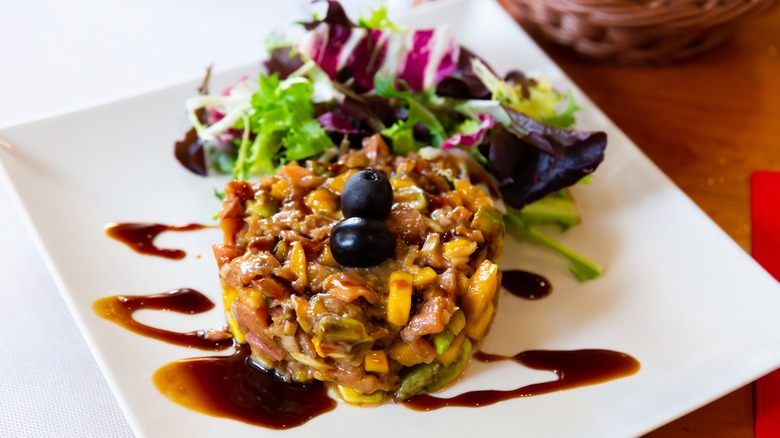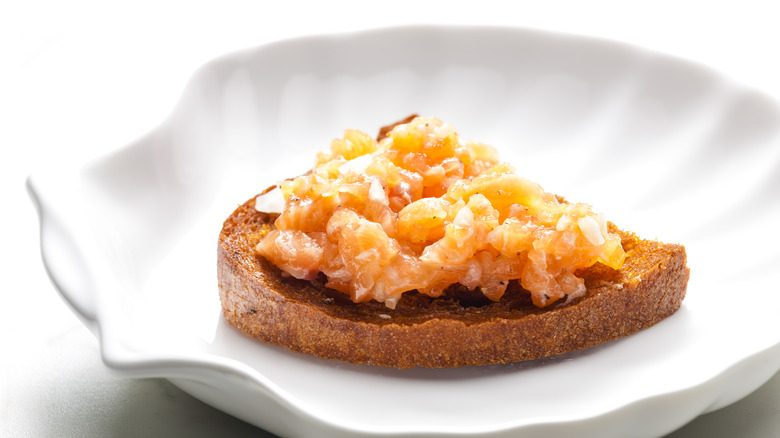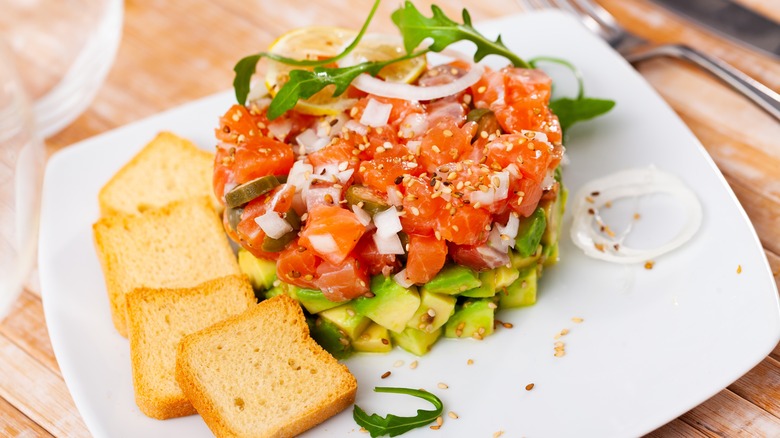Smoked Salmon Tartare Is The Solution To A Steak-Free Dish
We may receive a commission on purchases made from links.
You're probably familiar with steak tartare. It is one of those simple yet elegant classic dishes experiencing renewed popularity as a staple on restaurant menus. Sirloin or filet mignon is minced and mixed with Worcestershire, Dijon mustard, or other savory sauces and seasonings, then topped with a raw egg. The end result is rich and satisfying. It's also possible to create a tartare-style dish using veggies or other meats, including lamb, venison, mushrooms, tuna, or even smoked salmon. Chefs have even been toying with the sauces and seasonings from wasabi and fish sauce to custom aiolis and avocado.
Smoked salmon (the cold version) is a cured, low-temperature smoked meat, so technically it's raw. On its own (or, even better, blended with sashimi-grade raw salmon), it makes an impressive tartare dish with all the texture, richness, and complexity of the beef version. Similar to tuna tartare, which has a rich history, it's an ideal option as an appetizer, a lighter interpretation of the classic, and for those avoiding red meat. While a bit of prep is involved, there's no cooking and it all comes together pretty quickly (no marinating or chilling before serving). And as with steak tartare, there's a lot of room to customize the recipe.
Cold smoked vs hot smoked salmon tartare
There are plenty of salmon tartare recipes, so a guide for understanding all things salmon is helpful. Cold smoked salmon (also called Nova lox) is made by curing raw fish with salt (and often sugar) and partially dehydrating/smoking it using low, indirect heat (below 85 degrees Fahrenheit). It keeps in the refrigerator for several weeks and breaks apart easily for inclusion in eggs, cream cheese, and salads for a burst of intense salmon flavor. Cold smoked salmon is also the best option for tartare.
Hot smoked salmon (also called kippered salmon) is slow cooked over direct heat. Here the temperature hovers above 180 degrees Fahrenheit, and the end result is a fully cooked, succulent, and flaky piece of fish. It's a slow-baked filet that needs no additional treatment beyond preferred toppings.
Lox, another cold cured fish, is made by soaking salmon for several weeks in either a dry brine with salt (or salt and sugar) or a wet brine with salt and seasonings. Lox is also technically raw. In contrast with cold smoked versions, however, it has a higher perceived saltiness and no smoky notes.
As with any raw meat, it's important to note that there is some risk in consuming them. For people avoiding raw fish for health or safety reasons, cold smoked fish (and lox) should be treated the same way. It's prudent to wash your hands well after working with raw meat.
How to prepare smoked salmon tartare
The key to great salmon tartare is twofold: a delicious, savory binding sauce and mincing the fish so the finished dish will maintain its structure on crackers and can be shaped using plastic or metal molds, like this set of four from Hulisen. Some recipes call for 1/4-inch cubes, but cutting it even more finely also works well. Of course, you can also artfully plate an unmolded scoop alongside garnishes or top crackers with individual dollops of tartare.
If you like, simply mince the meat and mix in flavorings (lemon zest, minced onion or shallot, salt, and pepper). Or add a light sauce to better bind the meat. Consider soy or fish sauce in place of Worcestershire or a mix of gochujang and mayo or sour cream (no more than 1 tablespoon per 10 ounces of meat). Blending in an equal amount of raw sushi-grade salmon filet adds a creamy texture. Slicing salmon straight from the refrigerator is easier than after it's had a chance to warm up.
In place of traditional raw egg, use salmon roe or caviar. You can serve tartare with or atop crackers or toast points. For a more veg-forward dish, use cucumber or tomato slices, or rest it on a bed of diced avocado. If you don't like roe, top with a bit of crème fraîche and minced scallions. Since smoked salmon varies in flavor due to seasonings, fattiness, and smoke levels, you may need to play around to find your ideal tartare.


